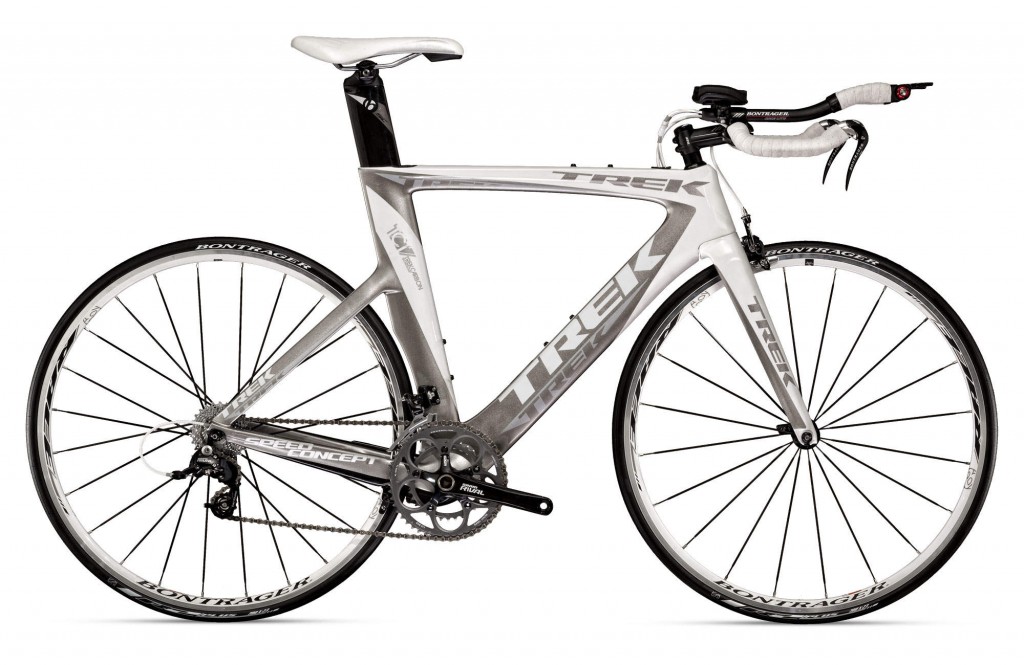- Speed Concept 7.2
Speed Concept 7.2 First Look Aerodynamic wizardry makes you faster. The holy grail of aerodynamic shapes is an airfoil with a five-to-one ratio of leading edge to width. While appropriate for airplanes, such shapes are not practical for bicycle frames (and not legal for racing). In designing its new Speed Concept series of time-trial and tri bikes.
Trek borrowed current technology from the auto industry, lopping off the tail end of a five-to-one airfoil, resulting in the bike’s squared-off Kammtail Virtual Foil (KVF) tube shapes, the heart of the Speed Concept series. Trek says KVF frames perform better in crosswinds than any similar frame that’s come before, while remaining fast in headwinds.
Wind-tunnel geekery aside, the bike felt great on the road, holding rock-solid in a straight line and while carving corners. My weight was nicely distributed, letting me take aggressive turns both in and out of the aero bars. The head-tube height felt perfect and offers a full range of positions, from low to more upright. Trek says one of the bike’s key benefits is its ability to fit a wide range of riders and riding styles.
 The cockpit exemplified this flexible fit. A quick turn of a wrench slides the Bontrager Race Lite clip-on bars in and out and adjusts the angle of the S-bend extensions. The armrests move easily front to back and side to side. The large flat section and slight rise near the end of the extensions accommodate different hand positions. Bontrager Race Lite aero brake levers look sharp and felt solid under hard deceleration.
The cockpit exemplified this flexible fit. A quick turn of a wrench slides the Bontrager Race Lite clip-on bars in and out and adjusts the angle of the S-bend extensions. The armrests move easily front to back and side to side. The large flat section and slight rise near the end of the extensions accommodate different hand positions. Bontrager Race Lite aero brake levers look sharp and felt solid under hard deceleration.
A single-bolt seat clamp makes saddle adjustments a breeze, and I found the Vision AeroMax Tri saddle’s soft nose and harder back end to be a nice blend of comfort and performance. One major issue: The seatpost kept slippping, even with the hidden clamp tightened to specified torque. Trek attributes this to a slightly undersize seatpost. New bikes ship with a revised post and early purchasers can get a free clamp assembly from Trek to eliminate the problem.
The seatpost allows for 10mm of fore-and-aft adjustability, but the bike’s 78-degree seat-tube angle doesn’t allow for much saddle setback. This is fine for triathlons, but will keep you from getting most saddles far enough behind the bottom bracket to comply with UCI and USA Cycling TT rules–professional athletes on Trek-sponsored teams receive a different post to address this issue.
One glaring gap in the 7.2’s spec is its low-end Bontrager Race Lite wheels, which I found heavy and flexy compared with the race wheels I’m accustomed to. Trek said it chose these wheels to keep costs low and let customers chose their own set to race on. I was also thrown off by the bike’s 50/39 compact crank. Trek says that it chose this spec in reaction to a trend toward a higher cadence among triathletes, but for powerful riders a 53 would almost certainly lead to faster times.
Even with these concerns, the 7.2 provides plenty of performance at a value for this type of bike. It’s a worthy investment for for any rider looking to gain time against the clock.
Watch The Video Review
Five things to expect from a bike like this:
Bar-end shifters on aero extensions, brake levers on a base bar
Rear wheel nestled in a frame cutout
Frame tubes shaped to optimize aerodynamics
Saddle with extra padding in the nose
Steeper seat-tube angles, often around 78 degrees
Three things to look for in a bike like this:
Brake calipers hidden behind the fork or under the BB shell
Deep-profile aero wheels on only the most expensive models
Internal cable routing
Buy it if: You want a dedicated tri bike, but don’t want to dip into Junior’s college fund
Forget it if: Your bike split at Kona was faster than five hours
Summary =
In designing its new Speed Concept series of time-trial and tri bikes, Trek borrowed current technology from the auto industry, lopping off the tail end of a five-to-one airfoil, resulting in the bike’s squared-off Kammtail Virtual Foil (KVF) tube shapes, the heart of the Speed Concept series. Trek says one of the bike’s key benefits is its ability to fit a wide range of riders and riding styles.
Bontrager Race Lite aero brake levers look sharp and felt solid under hard deceleration.
Trek attributes this to a slightly undersize seatpost. The seatpost allows for 10mm of fore-and-aft adjustability, but the bike’s 78-degree seat-tube angle doesn’t allow for much saddle setback. Trek said it chose these wheels to keep costs low and let customers chose their own set to race on. Bar-end shifters on aero extensions, brake levers on a base bar
Rear wheel nestled in a frame cutout
Frame tubes shaped to optimize aerodynamics
Steeper seat-tube angles, often around 78 degrees
Forget it if: Your bike split at Kona was faster than five hours.
Source = bicycling


